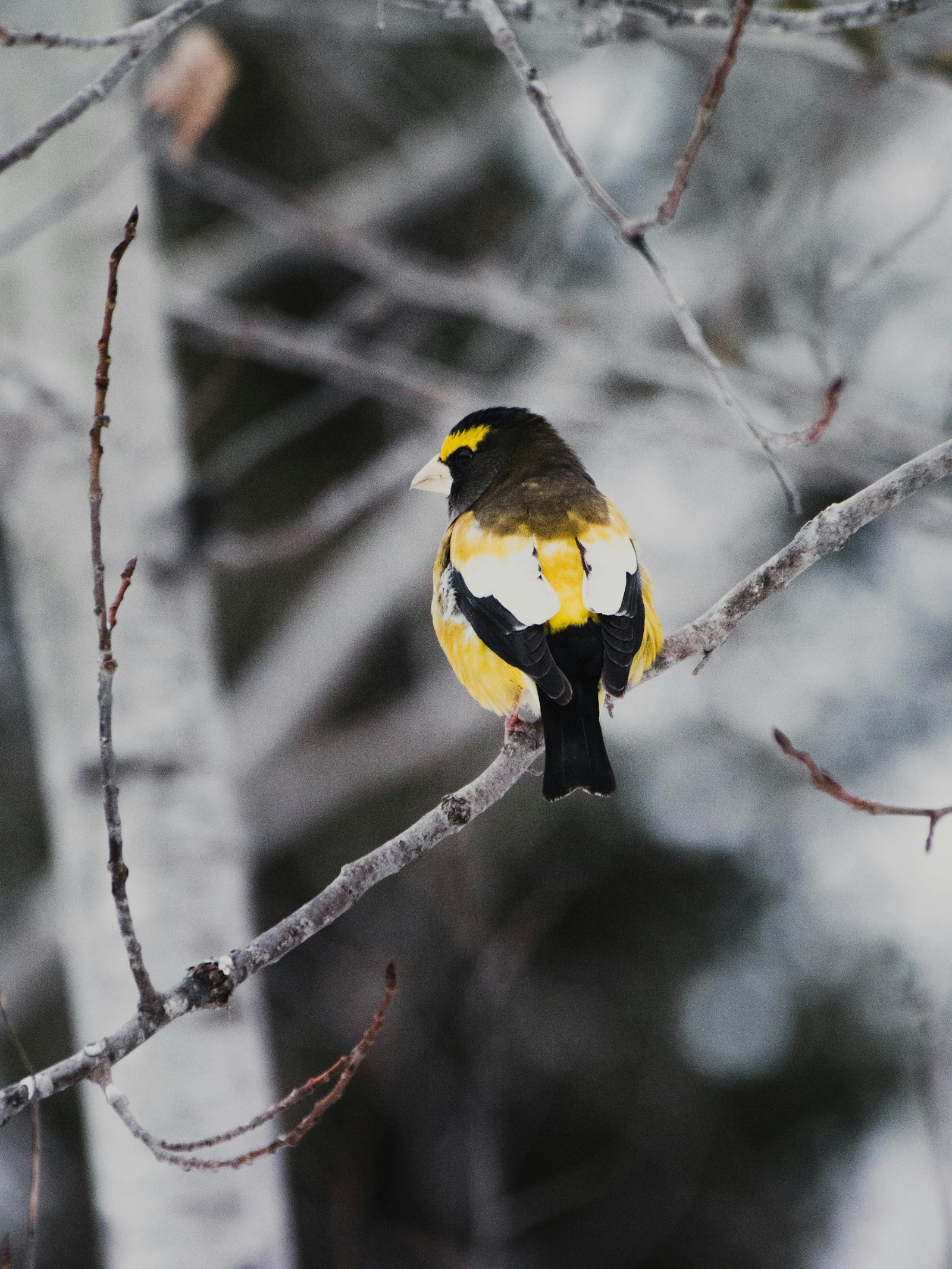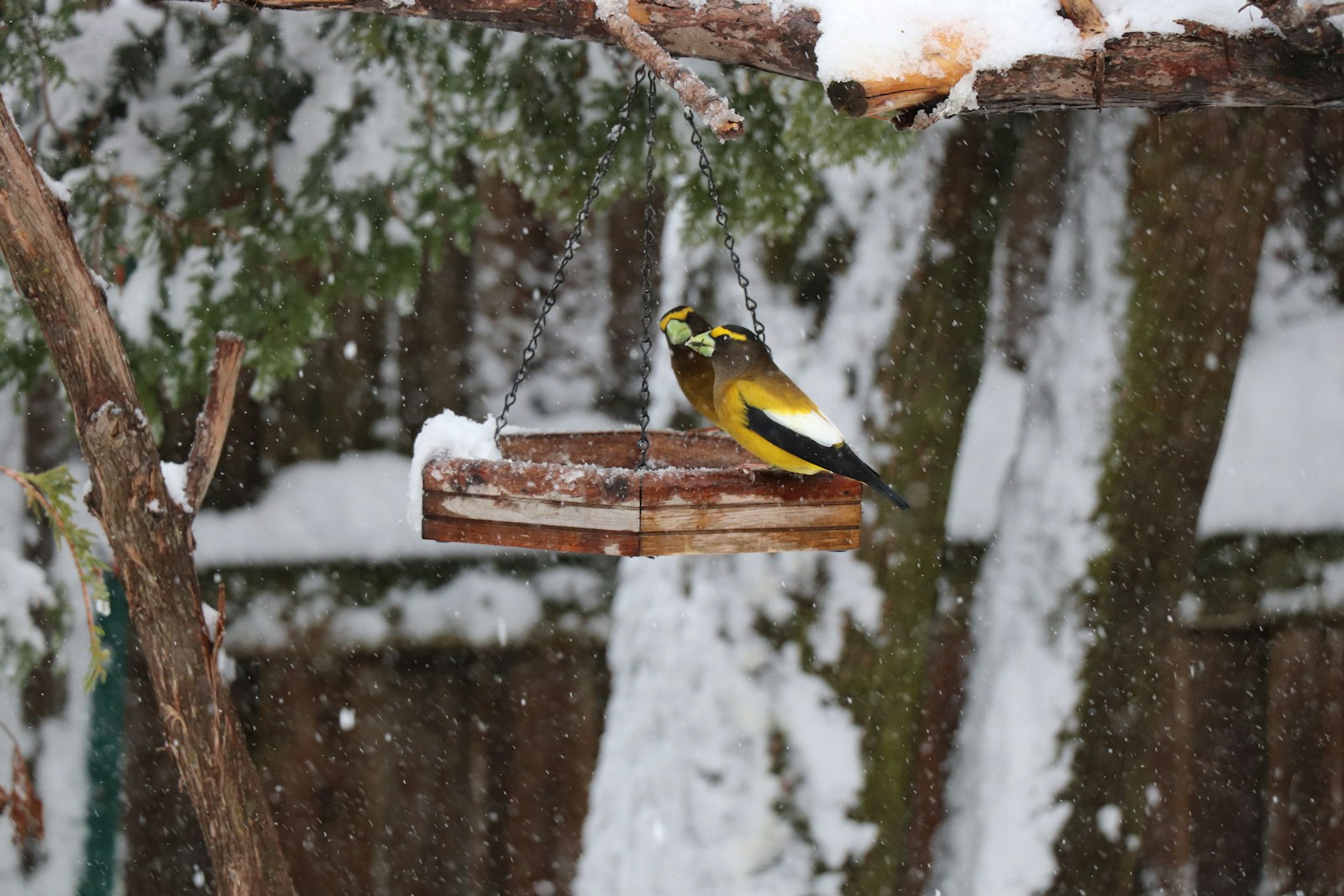By Rory Hale – REALTOR®, Rural Properties & Acreages in the foothills of Alberta
The Evening Grosbeak of Alberta’s Foothills
In the hush of an early spring morning, when the mist clings to the evergreens and even the chickadees are still rubbing sleep from their feathers, there’s a sudden bolt of yellow—so bright it seems to carry the sun in its wings. That’s your first hint that an Evening Grosbeak is near.
These birds don’t sing like robins or flit like finches. No, the Evening Grosbeak is the strong, silent type. Broad-shouldered (by bird standards), thick-billed, and robed in dramatic shades of lemon yellow, black, and white, the male Evening Grosbeak looks like he’s dressed for a gala where the theme is “mid-century superhero.” The females are softer in hue—pale gray with hints of yellow-green—but equally elegant.

Why So Yellow?
Their stunning coloration, especially that radiant yellow, is likely a mix of diet and display. Carotenoids from seeds and berries boost the brightness, but it’s the showmanship that seals the deal—males need to look sharp for mating season, and those bright feathers scream “healthy genes.”
A Home Among the Pines
In the Alberta foothills, Evening Grosbeaks are at home among mixed woodlands—particularly areas with spruce, fir, and pine. They like the higher elevations and the quiet of more mature forests, often near rivers or natural clearings. If you’ve got acreage with a line of old conifers and a sturdy feeder, you just might tempt them down for a visit.
These birds aren’t backyard regulars like the house finch—but when they do show up, they arrive in numbers and make a lasting impression. They travel in flocks, often family groups, and they carry a kind of serene authority wherever they go.
The Beak That Means Business
Evening Grosbeaks are seed specialists, and that heavy, conical beak is built for cracking even the toughest shells. Sunflower seeds? Gone in seconds. Maple buds, spruce seeds, fruit pits—they can handle it all. In summer, they’ll supplement their diet with insects, especially during nesting when hungry chicks need protein.
They eat with focus and force, sometimes scattering shells in all directions. If you see one at a feeder, take a moment to watch how it handles seeds with the efficiency of a seasoned forager.
Courting, Nesting, and Family Life
Breeding season in the foothills begins in late spring. Males court females with fluttering dances and quiet chirps—nothing too flashy, just enough to prove he’s attentive. Once paired, the female builds a loose, shallow nest high in the trees, usually from twigs, grass, and pine needles.
She lays 2–5 eggs, and the young fledge in about two weeks. Both parents feed the nestlings, though the mother does most of the brooding. Evening Grosbeaks are discreet parents—there’s little noise, no drawn-out serenades. They slip through the woods like quiet caretakers.
The Voice of a Rusty Swing
Their vocalizations aren’t what you’d call a song. It’s more like a series of short, sharp whistles and creaky chirr sounds—strange and mechanical, like an old gate that hasn’t been oiled. But once you know it, you’ll hear it in the trees long before you see that flash of yellow.
These calls serve more as flock communication than territorial songs. It’s their way of keeping tabs on each other in the dense canopy.
Do They Stay or Do They Go?
Evening Grosbeaks are irruptive migrants—which means they don’t follow a set migration schedule. Instead, they move based on food availability. In some years, they stay put through the Alberta winter, especially if conifer seed crops are abundant. Other years, they head south in search of better foraging.
This unpredictable movement is part of their charm—and their mystery. You might go three winters without a single sighting, then one December morning, your feeder is a flurry of gold and black.
Bright, Bold, and a Little Bit Curious
Are they curious? In a word: yes. While they aren’t as inquisitive as a raven or as tame as a chickadee, Evening Grosbeaks will watch you from the trees with their dark eyes. They’ll return to a quiet feeder again and again, especially if you keep a good seed mix on hand. They’re cautious, but not aloof.
Their presence feels like a gift. They don’t demand attention, but they reward the patient and the observant.
Why They Matter
Evening Grosbeaks are in decline across much of their range, largely due to habitat loss and changes in food availability. That makes every foothills sighting even more special. They remind us of the richness of Alberta’s wild places—and of what we stand to lose if we don’t protect them.
So next time you’re out for a stroll among the spruce or sipping coffee on your deck, keep your eyes peeled. You might just catch a glimpse of golden thunder in the trees.
And if you ever need a quiet spot of your own in the woods to watch for birds like this, well—I know a few places.
Conservation and Wonder
Evening Grosbeaks have declined across much of Canada. Habitat changes, pesticide use, and climate shifts may all play a role. That makes every foothills sighting even more meaningful.
If you’re lucky enough to share space with them, consider planting native trees or setting up a feeder to help them out.
Rural Living Bonus: Birdwatching Bliss
Living in Alberta’s foothills offers a front-row seat to nature’s quieter miracles—like the Evening Grosbeak. These birds don’t show up in city parks or suburban hedgerows. They belong to the forests, the valleys, and the kind of land where silence and trees stretch for acres.
And if that kind of lifestyle speaks to you, I’d love to help you find your own piece of foothills paradise.
Want to Learn More About Rural Alberta Wildlife?
Explore other blog posts on foothills birds, wildlife stories, and the joys of rural property ownership on my Blog.
Looking for Acreage in the Alberta Foothills?
I’m Rory Hale—your local rural real estate expert, nature enthusiast, and foothills neighbour.
📞 Contact Me or call 403-585-6552
🔎 Browse Acreage Listings
🌲 Let’s find a property where nature comes to your doorstep.


